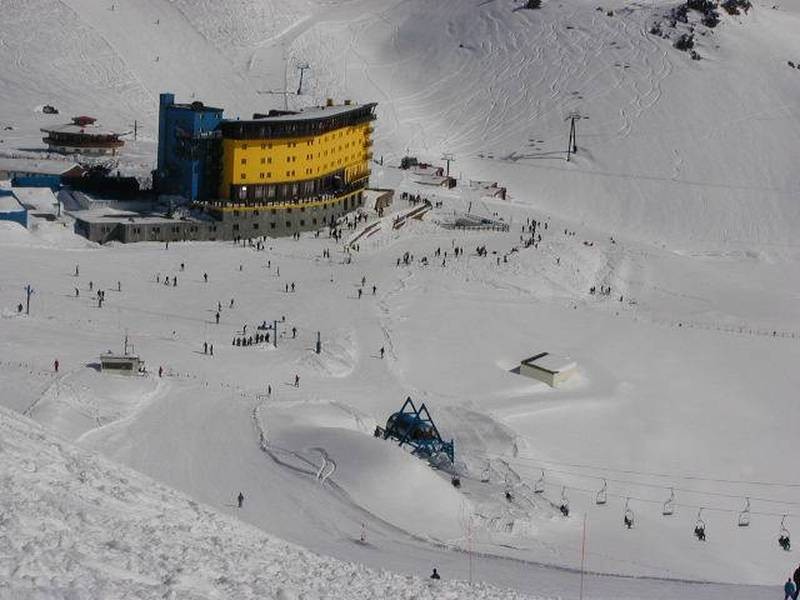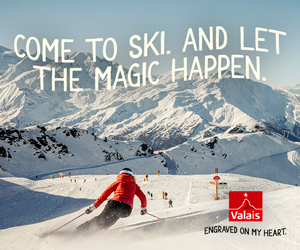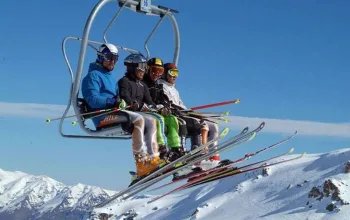Chile's original resort and important in world skiing, hosting numerous international events including the 1966 World Championships. People began sk iing from the Argentina-Chile railway line in 1890. Virtually all of the resort's accommodation and activities concentrated in the huge hotel complex. Today there's one employee for every guest resulting in high service standards. The resort offers easy and intermediate groomed slopes plus some of the toughest skiing in the southern hemisphere, with heliskiing an option, giving views of the Western Hemisphere's highest mountain - Aconcagua.
Mountain
Portillo is a training area for the world's top ski teams and when the US team visit in late August guests have the chance to watch them race as well as mix with them inside the hotel and on the slopes. The ski area rarely has lift lines, unsurprising with a ratio of 12 lifts to 450 guests and there's plenty of untracked powder - usually at its best in July. The average annual snow fall is 6m/20 feet and the ski season is normally from mid-June to early October with "high season" in late July due to South American school holidays. Actual high season for conditions are the months of July, August and September. The slopes are right outside the Hotel door . The beginner area is conveniently close to the hotel and Canarios seems to be a favourite with most learners while Juncalillo is preferred by cruisers and intermediates for its rolling slopes through valleys. The lower section, Los Tuneles passes over 2 long tunnels which the government had to build over the road because the ski run was there first! Nightly grooming keeps the pistes in top condition while the more extreme terrain is left with its natural snowpack. The Portillo Ski School, with a staff of 35 professionals from eight different countries, assures that the learning will be fun and memorable no matter what language you speak. With specialized programs for skiers of all ages and levels of expertise, this team of professionals offers the latest in technique and instruction to guarantee a great ski vacation. The recommended way to ski Portillo is to start on the Juncalillo side in the morning. It is possible to watch the sunrise from a bunk in the Inca Lodge as the light descends the east-facing slope and eventually reaches the Roca Jack, the first run to soften in the early morning sun. Roca Jack is a clear favourite among advanced skiers at Portillo and is accessed by one of the famous Va et Vient lifts. The Roca Jack carries 5 skiers while the other one on Condor takes 4 at a time. Conventional lifts were no use because unloading areas could not be constructed on the steep alluvial deposits and a lift tower could never withstand the avalanches which regularly pour down these chutes. Jean Pomagalski designed the Va et Vient and overcame the problem. The lift is a cross between a conventional tramway and a towerless cable tow but has 3 bullwheels. One is mounted at the bottom on a regular lift tower; the other two are attached to wires anchored in rocks high in the chute. The upper bullwheels are then kept suspended in the air by the tautness of the haul rope which makes a triangular shape and can run both forward and back. Two tow bars with platter seats are attached to the haul rope, and an operator starts and stops the lift at designated points. When an avalance hits the lift, the cable drops and is buried so after the storm a crew can locate and cut it. After it has been repaired or replaced the cable can be easily reinstalled. This entire process can be completed within 48 hours after the storm. Getting on the lift is the same as getting on a regular Poma lift and the ride up is fast and steep and feels like waterskiing. Unloading is fairly simple but really has to be prearranged so everyone knows what they're supposed to be doing. Another recommended advanced run is Garganta just to the north of the Plateau chairlift, it starts off in a narrow steep chute then opens out into a wide bowl. There are usually good moguls on Plateau and free timed race courses and Guest races are held every Thursday with a prize ceremony later on at night in the hotel's Living Room. Roca Jack is the FIS approved downhill run and Plateau where Jean Claude Killy took gold in the 1966 World Alpine Ski Championships is certified for slalom and giant slalom races. The Kilometro Lanzado has been the venue for 3 downhill speed trials with a new world record being set on each occasion. The latest was in 1987 when Michael Prufer of Monaco set the new record of 217.68Kph. Portillo is not really suitable for cross-country skiing due to avalanche risk which threatens the few flat areas suitable for the sport. The only terrain really appropriate for cross-country would be the frozen lake surface or possibly around the Los Libertadores customs station. Heli-skiing is available in Portillo on a pay per flight plus run basis.
Families
The Ski School have their own specially designed childrens' programme. Kid's Camp is a weekly program for 3 to 6 year olds which will introduce first-timers to skiing and encourage kids to enjoy their time in the snow. Childrens' lessons have been conveniently timed to fit in with parents' participation in their own Ski School group. Complimentary daycare is available for children up to 6 years old, and private night time babysitting is available for a small charge. At certain times of the season there are Free Kids' Weeks when each parent may bring one of his or her children of 12 or under completely free (this includes room, skiing and meals). An entertainment team creates a schedule of activities for young children and teens for the after skiing hours, both in the afternoons and evenings. Kids are safe in Portillo as all the activities and entertainment are contained within the one large hotel complex. Facilities include the giant Games Room where kids have a choice of pool and ping pong tables and electronic games, the high school style gymnasium with scheduled tourneys of soccer, basketball and volleyball, the heated outdoor pool, the cinema, and a variety of other activities. Kids should not miss out on participating in the Sol de Portillo Guest Race which is held on a Thursday with the prize giving ceremony later on in the hotel's Living Room.
Eating Out
The main Dining Room at Portillo dominates the second floor and seats about 500 people. It is rich with tradition and maintains an air of respectable formality where smart but casual dress is very much the order of the day. Dinner jackets are no longer required for men but nice casual clothing is requested for dinners. South America being a more formal society than North America means that baseball caps and T-shirts in the Dining Room can be offensive to many of the other guests who may hail from Argentina, Chile, Peru or Brazil. The best tables sit up next to the huge picture windows with an amazing view of the Inca Lake. Do try the tap water, its among the best tasting in South America. Chile's incredibly long coastline means that Chileans enjoy an enviable variety of seafood, from delicious salmon and sea bass to king crab, shrimp and scallops. Cooks prepare shellfish, including locos (abalone), the world's only edible barnacle, the also unique machas (similar to razor clams), mussels and "shoe-sized" mussels, with a variety of recipes, soups hot and cold being among the most common. Another Chilean pride is their wine and Portillo offers over 50 different wines on its menu. Four meals per day are served with dinner served late in the Chilean custom. Guest accustomed to eating early are advised to eat something during the tea hour and dine again later. Guests from the Inca Lodge, day visitors and ski staff eat in the self service cafeteria located on the first floor. The self-service menu features homestyle foods with 4 meals daily. Tio Bob's (Uncle Bob's) is the slopeside restaurant at the top of Garganta. The views are spectacular and its rarely crowded at lunchtime because hotel guests eat in the Dining Room. The menu consists of meats broiled over an open flame, an appetising salad bar and fresh fruit all washed down with Chilean wine. Tio Bob's is also a popular night time private party spot with a starlit chairlift ride adding another unforgettable dimension to the experience. La Posada, a small pub just across the highway from the hotel is where Portillo's staff tend to socialise and its said to be the place to go for a "down n' dirty dancing bash". The parties rock in La Posada especially in mid-September when the Chileans celebrate their independence with chicha, a homemade wine, and the cueca dance which the men practice amongst themselves or with any lady bold enough to join them. One drink everyone should try during their stay in Portillo is Pisco Sours, a delicious Chilean wine made from moscatel grapes.
Apres
Portillo has been designed for easy socializing and fun with all kinds of entertainment, activities and facilities to keep guests entertained after a day on the snow. The emphasis is very much on relaxation and well-being with aerobic and yoga classes happening regularly. The fitness centre includes gymnasium with weights and theres an outdoor heated pool. A sauna and massage are an excellent therapy to relax tired muscles and the beauty parlour is the perfect place for extreme self indulgence. The Living Room's comfy old couches make a great place to hang out, whether reading, playing chess or just enjoying a lazy afternoon by the fireside. The cinema has videos for most tastes and The Bar features live music and bands every night, the sun deck is a social centre and theres the cyber café, equipped with 9 computers, so you can check out your photos, surf the net or send a few e-mails. Letters and postcards to North America and Europe take from 5 days to a week by airmail. The swimming pool is an afternoon must while the Games Room attracts those who enjoy pool, ping pong and electronic games. Afternoon kids' games are organised and led by entertainment staff. The weekly torchligt parade is followed by dinner, live music in the Bar and a Goodbye Disco Party which is sometimes fancy dress so its worth packing a fun costume.
Boarding
With 100% of the area above the tree-line Portillo is a snowboarders playground. Every year more and more riders appear in Portillo. Surfers from Peru and Brazil, Extreme Team Visitors from the U.S. All of them help make Portillo a place to push your limits amongst an interesting group of riders. Helicopter adventures snowboarding arranged by request. The beginner area is conveniently close to the hotel and Canarios seems to be a favourite with most learners while Juncalillo is preferred by cruisers and intermediates for its rolling slopes through valleys. The lower section, Los Tuneles passes over 2 long tunnels which the government had to build over the road because the ski run was there first! Nightly grooming keeps the pistes in top condition while the more extreme terrain is left with its natural snowpack. The recommended way to ski or board Portillo is to start on the Juncalillo side in the morning. Its possible to watch the sunrise from a bunk in the Inca Lodge as the light descends the east-facing slope and eventually reaches the Roca Jack, the first run to soften in the early morning sun. Another recommended advanced run is Garganta just to the north of the Plateau chairlift, it starts off in a narrow steep chute then opens out into a wide bowl. There are usually good moguls on Plateau and free timed courses and Guest races every Thursday with the prize ceremony held later that night in the Hotel's Living Room.













